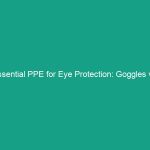Good Morning Team!
Today, we’re diving into a crucial topic that impacts our daily operations and overall Safety in the workplace: Essential Distraction Management Techniques: Minimizing Interruptions Effectively. Distractions can significantly affect our focus and efficiency, leading to potential Safety Hazards. Understanding how to manage these distractions is essential not only for our productivity but also for our safety and well-being.
Understanding Essential Distraction Management Techniques
So, what exactly do we mean by distraction management techniques? Essentially, these are strategies designed to minimize interruptions and enhance our ability to concentrate on tasks at hand. In the workplace, distractions can come from various sources—be it coworkers, technology, or even our own thoughts. Recognizing these distractions and implementing effective management techniques can transform our work Environment.
One common misconception is that distractions are merely a nuisance. In reality, they can lead to serious safety risks. For example, a distracted employee operating machinery may overlook critical safety protocols, resulting in accidents. Therefore, understanding how to manage distractions is vital for maintaining a safe work environment.
Key Hazards, Risks, and Safety Considerations
Distractions in the workplace can manifest in numerous ways, leading to various hazards:
- Reduced Focus: When our attention is scattered, we are more likely to miss important details, leading to errors.
- Increased Stress: Constant interruptions can contribute to heightened stress levels, impacting overall mental health.
- Injuries: In environments where heavy machinery is used, a lack of focus can lead to accidents and injuries.
Real-world consequences of ignoring distraction management techniques can be severe. For instance, a construction worker distracted by conversations may fail to notice a colleague in a dangerous position, leading to potential injuries. It’s crucial to recognize that managing distractions is not just about improving productivity but also about ensuring a safe work environment.
Best Practices, Procedures, & Actionable Advice
Now that we understand the importance of distraction management, let’s explore some practical techniques:
Create a Distraction-Free Workspace
One of the first steps to minimizing distractions is to create a workspace that promotes focus:
- Keep your desk organized and clutter-free.
- Use noise-canceling headphones if background noise is an issue.
- Designate specific areas for collaborative work versus focused tasks.
Utilize Time Management Techniques
Implementing time management strategies can significantly reduce distractions:
- The Pomodoro Technique: Work in focused intervals (25 minutes) followed by short breaks (5 minutes). This helps maintain concentration while allowing for necessary breaks.
- Time Blocking: Schedule specific blocks of time for different tasks, minimizing the chances of multi-tasking, which can lead to distractions.
Establish Communication Protocols
Effective communication can help manage interruptions:
- Establish “do not disturb” periods during which employees can focus without interruptions.
- Use messaging platforms efficiently, encouraging coworkers to save non-urgent requests for specific times.
Mindfulness and Focus Techniques
Incorporating mindfulness practices can enhance focus and reduce distractions:
- Take a few minutes at the beginning of the day to set intentions and prioritize tasks.
- Engage in short mindfulness exercises, such as deep breathing, to recenter your focus when feeling overwhelmed.
Regulations, Standards, and Compliance
It’s essential to recognize that distraction management aligns with various Workplace Safety regulations. Compliance with OSHA Standards, for instance, requires employers to ensure a safe working environment. By minimizing distractions, we not only comply with these Regulations but also foster a culture of safety and accountability.
Understanding and adhering to these standards is essential for protecting not only ourselves but also our coworkers. When everyone is on the same page regarding distraction management, we contribute to a safer workplace.
Employee Engagement & Discussion
Now that we’ve discussed essential distraction management techniques, I’d like to hear from you:
- What distractions do you encounter most frequently in your daily tasks?
- Have you implemented any techniques that have worked well for you in minimizing interruptions?
- What additional support do you feel you need to effectively manage distractions?
Let’s take a few moments to share our experiences and solutions. Engaging in this discussion can help us learn from one another and implement better practices across the board.
Conclusion & Key Takeaways
In summary, managing distractions is not merely about enhancing productivity; it is about safeguarding our well-being and the safety of our workplace. By creating a distraction-free environment, utilizing effective time management techniques, and fostering open communication, we can significantly reduce interruptions.
Remember, the goal is to prioritize safety and efficiency in everything we do. Let’s commit to applying these essential distraction management techniques in our daily operations. Thank you for your attention today and for your ongoing commitment to safety!


